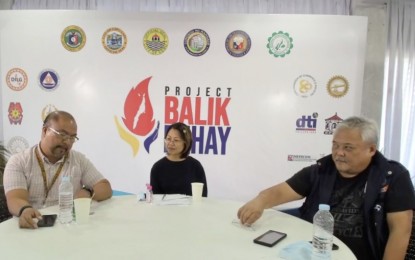
SEQUENTIAL LOCKDOWN. Department of Health (DOH-7) Regional Director Jaime Bernadas (right), Regional Epidemiology Surveillance Unit (RESU)-Region 7 Chief Dr. Junjie Zuasula, and DOH-7 Chief Pathologist Mary Jane Loreche, discuss the proposed guidelines on "sequential lockdown" of barangays that have high incidence of Covid-19 during a virtual presser on Friday (May 29, 2020). The proposed guidelines comprise three classifications – green (GCQ), orange (MECQ) and red (ECQ), depending on the number of Covid-19 cases and antibody prevalence using the rapid antibody diagnostic test. (Screengrab from OPAV video)
CEBU CITY – The Department of Health (DOH) in Central Visayas on Friday presented its proposed guidelines in implementing “sequential lockdown” of barangays (villages) that have high incidence of coronavirus disease 2019 (Covid-19) in the cities of Cebu, Mandaue and Lapu-Lapu.
Dr. Jaime Bernadas, DOH-7 regional director, said during a virtual presser that the guidelines proposed to the Regional Inter-Agency Task Force for the Management of Emerging Infectious Diseases (IATF-EID) will serve as a reference for the local government units in managing their villages in the battle against Covid-19.
Bernadas said the proposed guidelines were formulated after the strategic testing conducted to 10 percent of the total household population in the three cities from May 6 to 20.
The guidelines comprise three quarantine statuses with a corresponding number of Covid-19 cases and the antibody prevalence percentage ratio based on the immunoglobulin G (IgG) and immunoglobulin M (IgG) of patients who underwent rapid antibody diagnostic test (RDT).
Dr. Junjie Zuasula, chief of the Regional Epidemiology Surveillance Unit (RESU)-Region 7, explained that IgM and mixed IgM+IgG positive is a marker that a person’s body is reacting to a virus while the IgG is a marker that a person has previously been exposed to a virus.
In the guidelines, the “green” classification allows a general quarantine (GCQ) status for a barangay with zero confirmed Covid-19 case detected and zero percent of antibody IgM and IgM+IgG prevalence.
For the ”orange” status, an LGU can place a barangay under modified enhanced community quarantine (MECQ) in two levels – first level if one to 25 Covid-19 cases are detected using Reverse transcription polymerase chain reaction (RT-PCR) test and 0.1 to 1.0 percent of IgM and IgM+IgG and second level if a village has 26 to 50 coronavirus cases and with 1.1 to 5.0 percent antibody IgM or IgM+IgG prevalence.
On the other hand, an LGU can put a barangay under the "red" classification which is an enhanced community quarantine (ECQ) status if it has more than 50 Covid-19 cases and its antibody IgM and IgM+IgG prevalence rate is above 5.0 percent of its population.
Zuasula and Bernadas said the quarantine status declared in one barangay is dynamic, saying that it can either step down or step up, depending on the Covid-19 cases and antibody prevalence in the locality.
“To reassess the quarantine status, disease surveillance is a key, which means that they have to continue the enhanced ILI (influenza-like illness) and SARI (severe acute respiratory illeness) surveillance, maximize close contact tracing efforts using the trace, isolate, swab, treat,” Zuasula said.
Zuasula also said that each village must establish at least one barangay isolation center and initiate Covid-19 recovery surveillance to ensure that all Covid-19 positive patients who are both symptomatic and asymptomatic have recovered after 14-day quarantine or home isolation.
The DOH-7 officials presented the antibody prevalence in 135 of the 137 barangays in the three cities which can be used by the mayors in deciding which quarantine status they can implement using the proposed guideline.
“The result in the strategic mass testing on antibody prevalence using RDT will also serve as a reference for the employers in hiring or in dealing with their employees, considering that Covid-19 test for the workers is not mandatory,” Bernadas said. (PNA)
